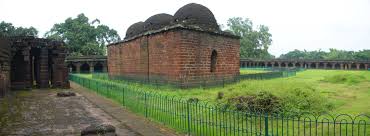Kurumbera Fort: Exploring the Historical Marvel of West Bengal
Kurumbera Fort, situated in the Paschim Medinipur district of West Bengal, is a fascinating historical site that offers a glimpse into the architectural and cultural heritage of the region. This lesser-known fort, with its unique blend of architectural styles, intriguing history, and serene surroundings, is a must-visit for history enthusiasts and curious travelers alike. Here’s an in-depth guide to exploring the marvels of Kurumbera Fort.
Arrival and First Impressions
Kurumbera Fort is accessible by road and is well-connected to major towns in the Paschim Medinipur district. The nearest town is Keshiari, approximately 5 kilometers away. As you approach Kurumbera Fort, the sight of its ancient walls and the tranquil countryside create a sense of anticipation and excitement, inviting you to explore its historical treasures.
Historical Significance of Kurumbera Fort
Kurumbera Fort, also known as Kurumbera Durga, dates back to the 16th century. It was built during the rule of the Gajapati rulers of Odisha and later modified by the Mughals. The fort served as a military outpost and a place of worship, reflecting a blend of Hindu and Mughal architectural styles.
Architectural Features
The fort is renowned for its distinctive architectural features, which showcase a fusion of different cultural influences. The unique design elements and intricate carvings make Kurumbera Fort a remarkable example of the region’s architectural heritage.
- Fort Walls and Gateways: The fort is surrounded by high walls made of laterite stone, with several arched gateways providing access to the interior. The walls and gateways are adorned with intricate carvings and motifs, reflecting the artistic skills of the builders.
- Temple Complex: Inside the fort, there is a large open courtyard with a central temple dedicated to Lord Shiva. The temple, built in the traditional Hindu style, features beautifully carved pillars, domes, and sculptures depicting various deities and mythological scenes.
- Mosque Structure: Adjacent to the temple complex, there is a mosque-like structure with domes and minarets, showcasing the Mughal influence on the fort’s architecture. This unique blend of temple and mosque elements is a testament to the syncretic culture of the period.
Exploring Kurumbera Fort
The Temple Courtyard
The central courtyard of Kurumbera Fort is dominated by the temple dedicated to Lord Shiva. The temple’s architecture is characterized by its ornate pillars, intricately carved walls, and a majestic dome. The serene atmosphere of the courtyard makes it a perfect spot for meditation and reflection.
- Intricate Carvings: The temple walls are adorned with intricate carvings depicting various Hindu deities, mythological scenes, and floral patterns. These carvings are a testament to the artistic excellence of the craftsmen of that era.
- Sacred Atmosphere: The temple courtyard, with its peaceful ambiance and spiritual significance, offers a tranquil space for visitors to connect with their inner selves and appreciate the cultural heritage of the region.
The Mosque Structure
Adjacent to the temple courtyard, the mosque structure adds a unique dimension to Kurumbera Fort. The presence of both Hindu and Mughal architectural elements within the same complex highlights the cultural diversity and religious tolerance of the time.
- Architectural Blend: The mosque structure features domes, minarets, and arches, showcasing the Mughal architectural style. The seamless integration of these elements with the Hindu temple architecture is a distinctive feature of Kurumbera Fort.
- Historical Insights: Exploring the mosque structure provides insights into the historical context of the fort, reflecting the coexistence of different cultures and religions during the period of its construction and use.
Practical Tips for Visitors
Best Time to Visit: The best time to visit Kurumbera Fort is during the cooler months from October to March. The weather is pleasant, making it ideal for exploring the fort and its surroundings. The post-monsoon period also enhances the beauty of the landscape, with the greenery looking lush and vibrant.
Accommodation: Accommodation options near Kurumbera Fort include guesthouses, eco-resorts, and budget hotels in nearby towns such as Keshiari and Kharagpur. Staying in these accommodations allows visitors to enjoy the tranquility of the countryside and the hospitality of the local community. Booking in advance is recommended, especially during peak travel seasons.
Transportation: Renting a car or hiring a local taxi is the most convenient way to explore Kurumbera Fort and its surroundings. Public transportation options are limited, so having your own vehicle provides flexibility and ease of travel. The roads leading to the fort offer scenic views, adding to the overall travel experience.
Safety and Etiquette: Respect for the historical site and local customs is important when visiting Kurumbera Fort. Follow all safety guidelines, avoid littering, and maintain a respectful distance from the structures. Dress modestly, especially when exploring the temple and mosque areas, and be prepared for varying weather conditions.
Reflection and Farewell
As my journey through Kurumbera Fort came to an end, I was captivated by the fort’s unique blend of architectural styles, rich history, and serene surroundings. From the intricately carved temple courtyard to the distinctive mosque structure, Kurumbera Fort offers a fascinating glimpse into the region’s cultural and historical heritage. Whether you are a history enthusiast, an architecture lover, or someone seeking a peaceful retreat, Kurumbera Fort promises an unforgettable visit.
Plan your trip to Kurumbera Fort and uncover the hidden marvels of Paschim Medinipur, where history, culture, and architecture come together to create a truly enchanting experience.






Leave feedback about this